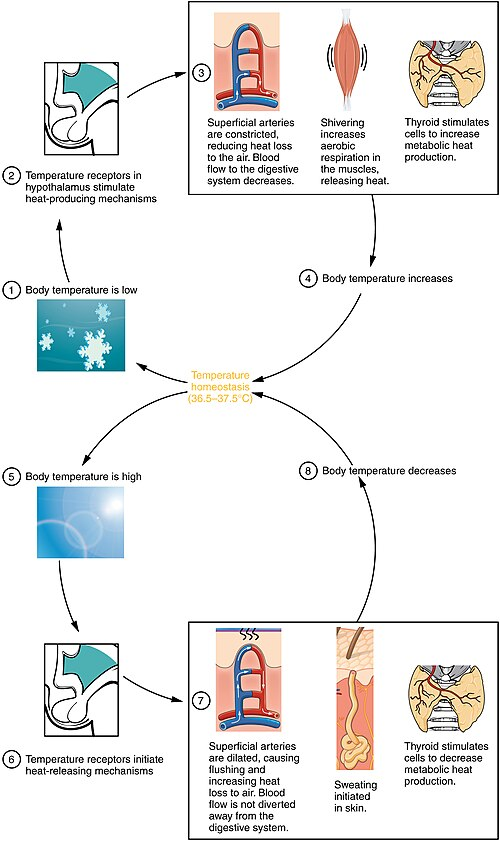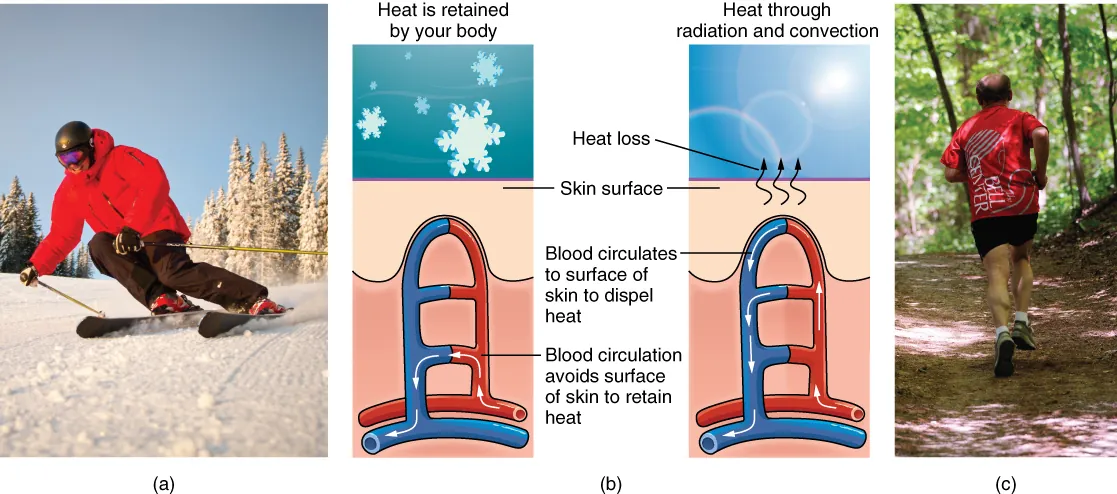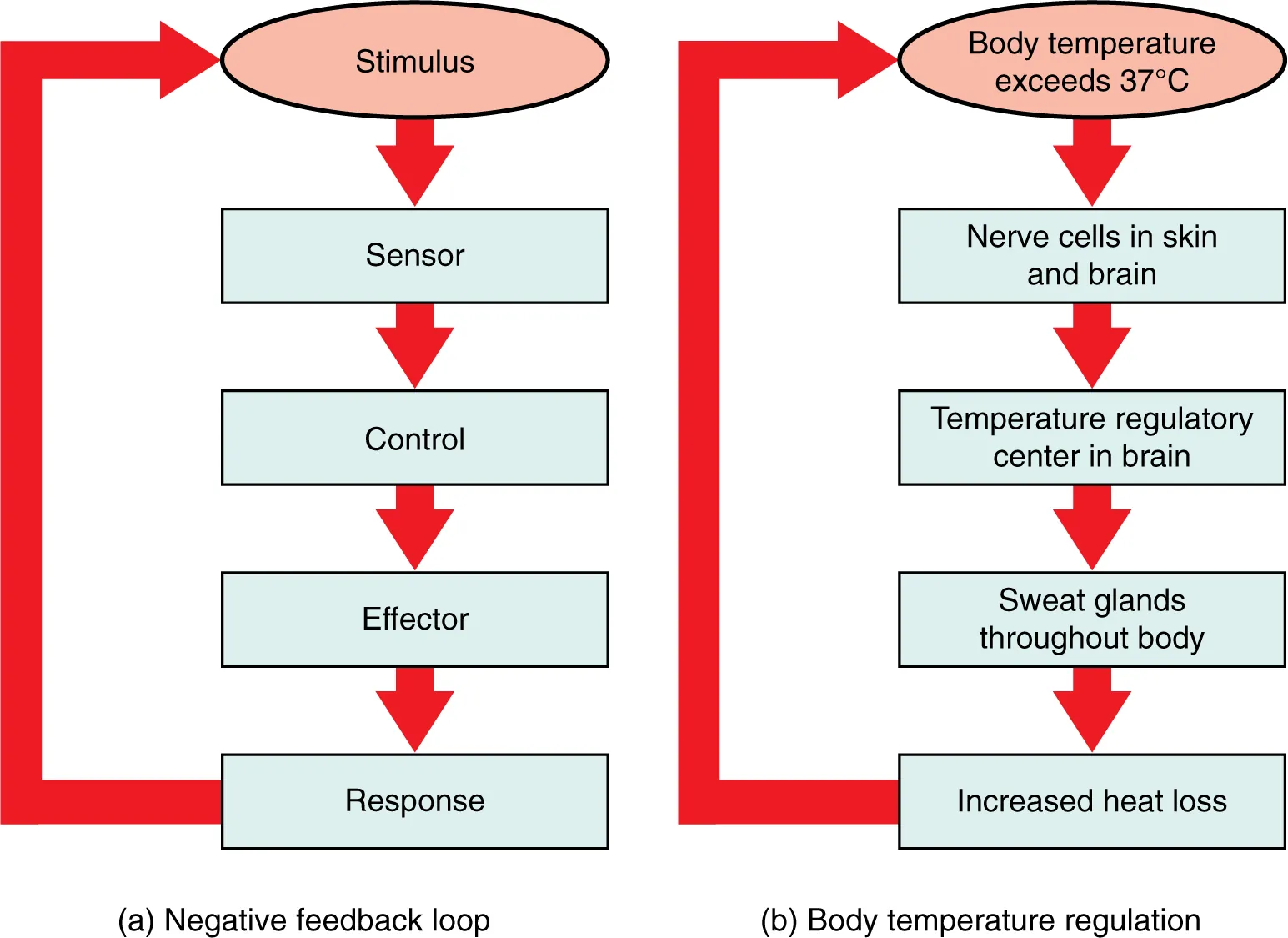OCR Specification focus:
‘Endotherms use peripheral temperature receptors, the hypothalamus, and effectors in skin and muscles, alongside behavioural responses, to control body temperature.’
Endotherms maintain a stable internal body temperature through precise physiological and behavioural mechanisms, allowing enzyme function and metabolic reactions to proceed efficiently despite external temperature fluctuations.
Understanding Endothermy
What Are Endotherms?
Endotherms are organisms that generate most of their heat metabolically, maintaining internal temperature independent of the environment. Mammals and birds are classic examples. This adaptation enables activity across diverse habitats but requires high energy intake to fuel metabolism.
Endotherm: An organism that maintains a constant internal body temperature using metabolic heat from within rather than relying on environmental heat sources.
Endothermy is a key evolutionary advancement, supporting sustained activity, efficient enzyme function, and survival in varying climates.
The Importance of Temperature Control
The Need for Thermoregulation
Thermoregulation ensures that core temperature remains close to an organism’s set point (usually around 37°C in humans). Deviations can disrupt biochemical reactions, as enzymes are sensitive to temperature change.
High temperatures: Enzymes denature, leading to impaired metabolic reactions.
Low temperatures: Reaction rates slow, causing reduced metabolic efficiency.
Thermoregulation: The maintenance of a constant internal body temperature within a narrow range, despite fluctuations in external conditions.
Maintaining this balance is a crucial part of homeostasis, the regulation of internal conditions necessary for life.
Components of Thermoregulation in Endotherms
Thermoregulation involves receptors, a control centre, and effectors—a classic homeostatic feedback system.
Peripheral Temperature Receptors
Located in the skin, these receptors detect external temperature changes. They provide early warning of environmental shifts, allowing pre-emptive responses before the core temperature is affected.
Cold receptors: Trigger warming responses.
Heat receptors: Stimulate cooling responses.
These sensory inputs are transmitted as nerve impulses via the sensory neurones to the hypothalamus.
The Hypothalamus: Thermoregulatory Control Centre
The hypothalamus, situated in the brain, acts as the central coordinator for temperature regulation.

Labeled diagram of hypothalamic control of thermoregulation. It traces inputs from skin and core receptors to the hypothalamus and outputs that drive vasodilation/sweating or vasoconstriction/shivering. This directly illustrates the sensor–control-centre–effector model used in endothermic temperature control. Source.
It contains two main regions:
The heat-loss centre, which activates when core temperature rises.
The heat-gain centre, which activates when temperature drops.
The hypothalamus integrates signals from:
Peripheral receptors (skin) detecting external temperature.
Core receptors (within the hypothalamus) monitoring blood temperature.
This integration ensures both anticipatory and corrective responses to maintain the internal set point.
Homeostasis: The maintenance of stable internal conditions through coordinated physiological mechanisms around a set point.
Effectors in Thermoregulation
Once the hypothalamus detects a deviation from the set point, it activates effectors via the autonomic nervous system to initiate corrective responses. These effectors include skin, muscles, and blood vessels.
Cooling Mechanisms (When Body Temperature Rises)
To dissipate excess heat:
Vasodilation: Arterioles near the skin surface widen, increasing blood flow to capillaries beneath the epidermis. This promotes heat loss by radiation.
Sweating: Sweat glands secrete fluid onto the skin; evaporation removes heat from the body surface.
Reduced metabolic rate: Lower metabolic heat production conserves energy and prevents overheating.
Hair lies flat: The erector pili muscles relax, reducing the layer of insulating air around the skin.
These processes collectively reduce core body temperature towards the set point.

Composite figure illustrating thermoregulatory responses at the skin. The central diagram contrasts vasodilation (enhanced surface blood flow and heat loss) with vasoconstriction (reduced surface blood flow to conserve heat); photos flanking the diagram give real-world context to exertion and cold. Note: the sporting photos provide extra context beyond the OCR requirement; the key content is the central capillary-bed diagram. Source.
Warming Mechanisms (When Body Temperature Falls)
When the hypothalamus detects a drop in core temperature, it triggers mechanisms to conserve and generate heat:
Vasoconstriction: Arterioles constrict, reducing blood flow to the skin’s surface and minimising heat loss by radiation.
Shivering: Rapid, involuntary muscle contractions increase metabolic heat production.
Increased metabolic rate: Hormones such as thyroxine and adrenaline elevate metabolic activity, generating heat internally.
Erector pili muscles contract: Hairs stand on end, trapping a layer of insulating air (especially useful in furry mammals).
These changes raise body temperature back towards normal levels.
Behavioural Responses in Endotherms
Endothermic animals complement physiological mechanisms with behavioural adaptations, consciously altering their actions to maintain temperature.
Examples of Behavioural Thermoregulation
Seeking shade or water to cool down.
Panting or licking fur to increase evaporative heat loss.
Basking in sunlight or curling up to reduce surface area exposed to the cold.
Huddling in groups (e.g. penguins) to conserve body heat.
Behavioural responses often occur faster than physiological changes, offering an immediate means of temperature adjustment.
Integration of Physiological and Behavioural Control
Endothermic thermoregulation is most effective when physiological and behavioural mechanisms work together. For example:
A human feeling hot (via hypothalamic detection) may seek shade or remove clothing.
A cold-blooded sensation (via peripheral receptors) may prompt shivering and movement to warmer environments.
This integration maintains thermal equilibrium, preventing both hyperthermia and hypothermia.
Feedback Mechanisms in Temperature Regulation
Negative Feedback in Thermoregulation
Thermoregulation operates through negative feedback, where deviation from the set point initiates a response that reverses the change.

Negative-feedback schematic using thermoregulation as the example. A rise in core temperature activates sensors and the hypothalamic control centre, which stimulates effectors to increase heat loss. This visual reinforces the roles of receptors, control centre and effectors specified by OCR. Source.
Example:
If core temperature rises, the hypothalamus triggers cooling mechanisms (vasodilation, sweating).
When temperature falls, warming mechanisms (shivering, vasoconstriction) are activated.
Once normal conditions are restored, these corrective mechanisms are inhibited, ensuring stability without oscillation.
Negative Feedback: A control mechanism that counteracts changes in a system, restoring conditions towards a set point.
Positive feedback, by contrast, amplifies change and is generally avoided in temperature regulation, as it would destabilise internal conditions.
Summary of Key Components
Receptors: Detect internal and external temperature changes (skin and hypothalamus).
Control Centre: Hypothalamus integrates information and coordinates responses.
Effectors: Skin, muscles, and blood vessels perform physiological adjustments.
Behavioural Actions: Complement physiological processes to maintain homeostasis.
Together, these systems ensure that endotherms maintain a relatively constant internal temperature, enabling survival and efficient functioning in fluctuating environments.
FAQ
The hypothalamus contains specialised thermoreceptor neurons that monitor the temperature of the blood flowing through it. These receptors respond to very small fluctuations—often less than 0.1°C.
If blood temperature rises, impulses are sent to activate heat-loss mechanisms such as sweating and vasodilation.
If it falls, the hypothalamus stimulates heat-gain mechanisms such as shivering and vasoconstriction.
This direct monitoring allows the hypothalamus to maintain a precise internal temperature set point.
Shivering continues briefly because there is a lag between heat generation and the hypothalamic feedback response.
Muscular contractions generate heat through respiration, which warms the blood.
Once core temperature approaches the set point, negative feedback signals reduce and stop the shivering reflex.
This short delay prevents rapid switching on and off of responses, maintaining temperature stability.
Adrenaline, released from the adrenal medulla, increases metabolic rate in tissues such as the liver and muscles.
This elevates heat production during cold conditions, supporting the hypothalamic heat-gain response.
Adrenaline also stimulates glycogenolysis, releasing glucose for respiration to supply ATP for shivering.
In this way, adrenaline acts as a hormonal amplifier, complementing neural thermoregulatory control.
In humid air, sweat does not evaporate efficiently because the air is already saturated with water vapour. As a result, evaporative cooling is reduced.
Vasodilation becomes the more effective mechanism because it increases radiative and convective heat loss from the skin surface.
However, when both mechanisms are active in dry conditions, they work synergistically for maximum heat dissipation.
Not all body areas play equal roles in thermoregulation.
Extremities (hands, feet, ears) lose heat quickly due to high surface area to volume ratios and extensive blood supply.
Core organs are insulated by fat and prioritised for constant temperature maintenance.
Counter-current heat exchange in some animals’ limbs conserves heat by warming incoming blood with outgoing blood.
Humans exhibit mild versions of this mechanism, particularly in cold weather, to minimise overall heat loss.
Practice Questions
Question 1 (2 marks)
Explain the role of peripheral temperature receptors in the control of body temperature in endotherms.
Mark scheme:
1 mark for identifying that peripheral temperature receptors detect changes in external temperature (e.g. heat or cold).
1 mark for stating that this information is sent as nerve impulses to the hypothalamus to trigger appropriate corrective responses.
Question 2 (5 marks)
Describe and explain the physiological mechanisms that occur in an endotherm when body temperature rises above its normal set point.
Mark scheme:
1 mark for reference to vasodilation of arterioles near the skin surface, increasing blood flow to the surface capillaries.
1 mark for explaining that vasodilation increases heat loss by radiation.
1 mark for describing activation of sweat glands and evaporation of sweat from the skin surface.
1 mark for explaining that evaporation removes heat from the body, cooling it down.
1 mark for noting that the hypothalamus detects the rise in temperature and sends impulses to effectors in the skin and muscles to initiate these cooling responses.

